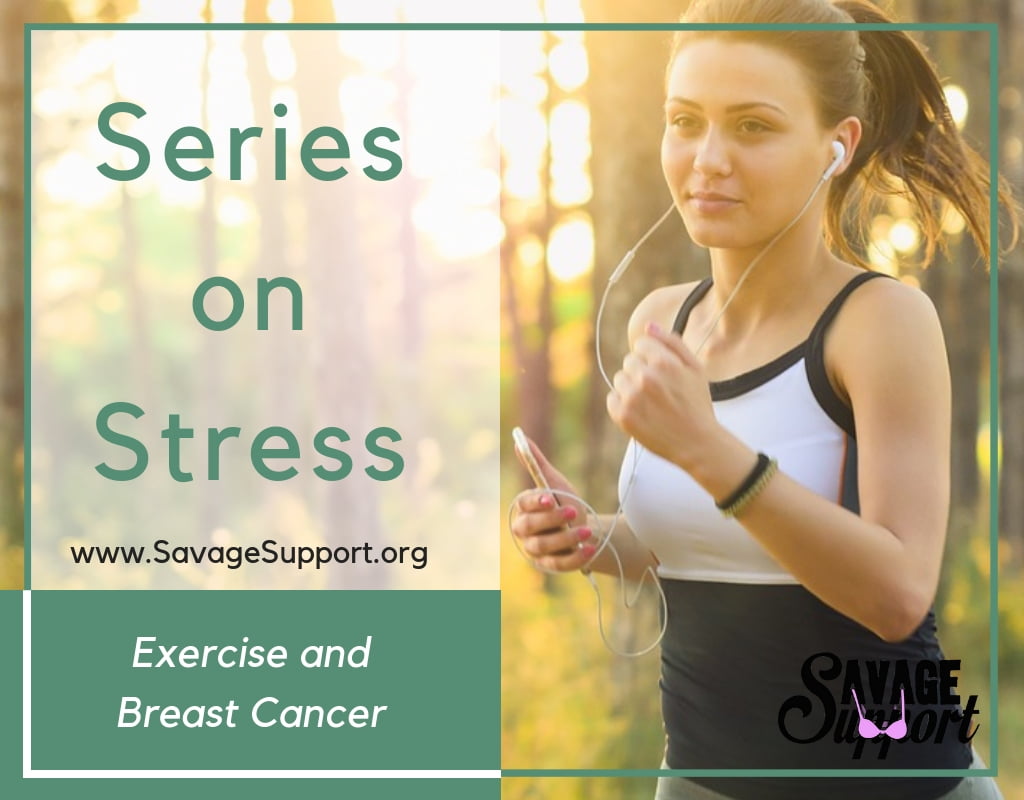Welcome back to our Series On Stress, where we look at how stress impacts treatment and recovery from breast cancer and how we can reduce stress in our lives to improve the outcomes of treatment.
This month we are looking at exercise and the effects it has, not only from a stress reduction standpoint but also how it improves treatment outcomes. Outcomes like battling fatigue, facilitating lymphatic drainage and how it can get most people back to feeling more normal after treatment.
We interviewed Dr. Leslie J. Waltke, Founder of the Waltke Cancer Rehabilitation Academy. Dr. Waltke is the Cancer Rehabilitation Coordinator for Aurora Health Care, one of the United States’ largest cancer programs and holds the rare Commission on Cancer “Outstanding Achievement Award.” Her role, in addition to treating patients with cancer, includes cancer rehabilitation program development, education and training, and best practice and clinical standards development.
As many of you know or have probably read elsewhere, exercise is a great way to reduce the physical and psychological effects of stress. The Mayo Clinic affirms that exercise releases chemicals called endorphins that are the bodys “feel good” chemical. They are typically associated with the feeling of a “runners high.” Exercise also offers a distraction from what may be stressing us by forcing us to do something different and engaging. Finally, exercise can improve our mood by building our self-confidence, improve relaxation and lower symptoms associated with anxiety and depression. But, according to Dr. Waltke, the health benefits from exercise are just as beneficial.

Leslie J. Waltke, PT, DPT
Cancer Rehabilitation Specialist
Dr. Leslie J. Waltke is a physical therapist with a mastery in cancer rehabilitation. She is an impassioned educator and advocate and teaches and lectures extensively both nationally and internationally.
Get a Physical Therapist!
A physical therapist is someone who uses therapeutic exercise and manual therapy to correct an injury and reduce pain associated with it. Dr. Waltke recommends cancer patients see a physical therapist during and after treatment as a way to ensure you stay as strong as possible during treatment and then return to a good health, function and quality of life as soon as possible after treatment.
“Studies indicate after breast surgery, there is a 30-50% chance people will have pain or limitation. Physical therapy can help minimize and eventually eliminate that pain. An important thing a physical therapist will do is incorporate stretching exercises and strengthening exercises after surgery to make sure that the soft tissues of the chest wall returns to full length, full mobility and full strength.”
The American Society of Clinical Oncology reports 40% of cancer survivors are living with long term pain after treatment. This is distressing because most of that could be corrected with a physical therapist according to Dr. Waltke.
“With rare exception, we want and expect people to eventually regain full, pain free function after breast surgery. If that is not the case for someone, they should seek out a physical therapist.”
The Effect of Fatigue
Fatigue is one of the most common and distressing complaints of people in cancer treatment. It makes everything more difficult, from going to get groceries, doing daily tasks around the house to even getting out of bed in the morning.
Dr. Waltke says “the only evidence based treatment for cancer related fatigue is exercise”. She suggests aiming for 150 minutes of mild to moderate exercise over the course of the week.
“You can break it up into 5 minutes here, 10 minutes there or you can do half hour chunks, depending on how able you feel and if there are any preexisting health conditions you may have.”
What Kind of Exercise Should I Do?
Starting a new exercise program can be daunting, especially if it is something that you don’t normally do. But, that’s okay! Dr. Waltke says that it can be anything aerobic like walking, cycling, or even dancing. Patients should aim for an exercise routine that focuses on strengthening both the arms and the legs as well as the heart and lungs.
“People should be strengthening their quadriceps, hamstrings and glutes because these large muscle groups drive our energy, health and metabolism. Studies show that those muscles may atrophy during chemotherapy, both from the drug and because people stop moving. This is linked to increased fatigue. My breast cancer patients are going to be on the leg press machine, they are going to be doing squats and stairs. Its critically important to maintain leg and core strength for anyone undergoing chemotherapy, regardless of what type of cancer they have.”
She also told us about the incredible effects that walking has on ensuring that breast cancer does not come back after beating it the first time.
“A critically huge piece of information that needs to get out there is that the research is very clear; breast cancer survivors that walk from 1-5 hours per week reduce their risk of recurrence of breast cancer. Exercise is actually medicine for people with breast cancer. Walking can reduce the risk of recurrence and it can reduce the risk of death.”
Make It Easy and Fun
So what advice does the woman in charge of cancer rehabilitation for a major medical organization suggest for getting started?
“The first couple times you exercise make sure that its so gosh darn easy that you don’t fail. When you are done, you should say “I either feel the same or feel better.” Success and feeling better when you are finished promotes continued compliance. “
“My other advice to you is that it has to be something that is easy for you and you enjoy doing and you have access to. Humans are creatures of habit. We aren’t going to do something we don’t like, especially when its challenging when you don’t feel well. You can walk in a pair of blue jeans. You can do weight exercises in your own home, you don’t have to go to a club or have fancy equipment.“
“I will always say that anything is better than nothing. So if you only have 5 minutes, then use the 5 minutes. That will be better than doing nothing. Then slowly build up from there. So if you can’t do 20 minutes in a row because you don’t have the energy or don’t feel well enough, then start with two or three periods of six or seven minutes of exercise per day, that’s absolutely fine. Build from there until you have the strength to do 20-30 minutes in a row.”
Parting Thoughts
Dr. Waltke shares that it really troubles her that so many people are still living with painful symptoms and fatigue post treatment, when we know much of that can be lessened with an exercise prescription.
“I think there is this underlying assumption in the cancer survivor world that “well I had cancer, I’m supposed to be miserable.” No you are not! In treatment yes, you may be miserable at times, but, once that’s all done, people should strive to get to 100%. And, I don’t think everyone knows that expectation so they are living with symptoms they shouldn’t have to.“
Whether you are newly diagnosed or years out from treatment, you will benefit from physical activity. Contact a physical therapist if you have lingering pain or if you are unable to exercise without help or supervision. “Exercise like your life depends on it, because it does.”
Get active, your body will thank you.

Leslie J. Waltke, PT, DPT
Cancer Rehabilitation Specialist
Dr. Leslie J. Waltke is a physical therapist with a mastery in cancer rehabilitation. She is an impassioned educator and advocate and teaches and lectures extensively both nationally and internationally.


0 Comments